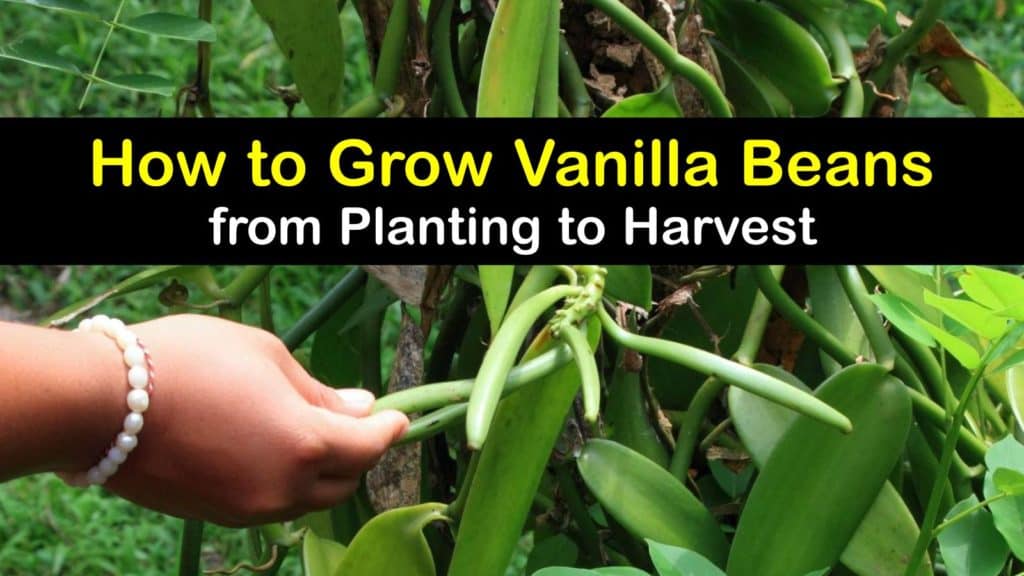Vanilla flavoring lends a delicious, sweet taste to desserts like ice cream. However, looking at the price tag on a bottle of vanilla extract might leave you wondering whether it’s possible to grow your own vanilla beans at home. If you’re up for a gardening challenge, learning how to grow vanilla beans might be your next DIY project.
The vanilla orchid, Vanilla planifolia, is a vining evergreen and the only member of the orchid family to produce edible seed pods. It has long, lance-shaped, fleshy leaves and fragrant white, green, or yellow flowers.
In the wild, the vanilla vine grows up to 100 feet long, wrapping itself around tree trunks. Houseplants stay a more manageable size but still require tropical-like conditions, including high humidity and heat.
The vanilla bean plant is most often grown commercially in Madagascar, Réunion Island, the Comoro Islands, Indonesia, Mexico, Hawaii, and Tahiti.
Vanilla growers need incredible patience and precision since the plant takes several years to flower but only blooms for one day.

Tips for Growing Vanilla Beans
How do vanilla beans grow? The vanilla bean plant thrives outdoors in USDA hardiness zones 10 and 11. Unless you live in one of these regions, you’ll have to replicate the conditions indoors or in a greenhouse. It’s much more challenging than when you plant bush beans.
How to Grow Vanilla Beans
The vanilla plant requires at least six hours of bright indirect sunlight daily. It also demands warm temperatures and a humid environment.
Grow vanilla beans in a container with a support like a wooden post or trellis, similar to the best way to grow pole beans that require something to lean on and grow up. Set up the plant in a greenhouse or warm sunny room.
Use orchid potting mix or a similar growing medium like sphagnum moss. It’s not recommended to try growing vanilla beans from seed. Instead, purchase cuttings or a vanilla plant from a local grower or online.
Fertilize regularly with orchid fertilizer and water until the potting mix is damp but not soaked. Keep the support damp as well since some vanilla roots draw their moisture from the air. Alternatively, mist your plant every day or two.

Keep an eye out for flowers, then pollinate them by hand. Vanilla pods should appear within a week of pollination but take up to nine months to mature. The curing process dries out the pods.
Creating the Perfect Environment for Vanilla Bean Plants
Before growing vanilla beans, spend some time thinking about how to create their preferred growing conditions. Remember the answer to “How do vanilla beans grow?” They twist up a support, typically in a tropical environment.
Ideal Light, Temperature, and Humidity for Vanilla Plants
Vanilla vines prefer bright indirect light. Hot direct sunlight scorches the plants, but they won’t bloom in deep shade. Dappled shade and morning sun are acceptable as long as the plants receive at least six hours of light daily, like when growing a pinto bean plant.
Try to keep temperatures above 60℉ since cooler temperatures lead to slower growth. Ideally, daytime temperatures should remain between 80 and 85℉. For nighttime temperatures, the range is 65 to 75℉.
Keep humidity levels high—between 80 and 85%. However, ensure proper air circulation to help prevent root rot.
Growing Vanilla Beans Indoors or in a Greenhouse
Unless you live in a tropical region with the proper temperature and humidity, you’ll have to grow your vanilla vine indoors. Choose a warm room or at least a spot by a sunny window. If the space does not receive enough light, install grow lights.
A greenhouse may be the best solution since it’s easy to control the heat and humidity. Increase the temperature with a heat lamp or heater, or decrease it by opening vents or running a fan. Adjust the humidity with a humidifier or dehumidifier.
Propagating Vanilla Bean Plants
Growing vanilla beans from seed is too challenging for most gardeners. Instead, look for cuttings or—to really speed up the process—a vanilla orchid plant.
Preparing Soil for Vanilla Bean Plants
The ideal vanilla growing medium is fertile, moist, and well-drained, with a pH of 6.5 to 7.5. Options to consider include orchid potting mix and damp sphagnum moss. Alternatively, use a blend of equal parts bark and all-purpose potting mix.
Use a clay pot with drainage holes that’s at least 12 inches deep. This size provides enough room for the roots to grow.
How to Grow Vanilla Beans from Cuttings
Plant vanilla cuttings in the spring when the weather is warm. Look for a cutting that’s 15 to 20 inches long and has at least six growing nodes.
You may be able to find vanilla orchid cuttings at a local florist or garden center. If not, order them online. Purchase several in case some are not successful.
Remove the bottom two leaves from the cutting, then bury the branch one inch deep. Gently press down the soil and water lightly with distilled water.
Growing Vanilla Beans from a Plant
How do vanilla beans grow? Slowly—it can take three to five years for the plant to bloom. If you don’t have that kind of patience, consider purchasing a plant.
Look for a vanilla bean plant or vanilla orchid from a local grower or online. Transplant the vine to a slightly larger pot. The container can be twice as large as the original as long as it doesn’t drown the plant.
Fill the pot halfway with your chosen potting mix. Gently squeeze to release the orchid, then transfer it to the new container. Add soil to fill the pot. If the plant’s roots form a ball, first loosen them with your fingers.
How Do Vanilla Beans Grow? Supporting Vanilla Plants
Use a wooden post, stake, bamboo pole, or trellis to support your vanilla plant. Make sure to use a type of wood that does not rot easily, such as cedar or cypress. The support only needs to be a few feet tall.
Insert the stake near the plant’s base, being careful not to damage the roots. Attach the main stem and any offshoots using plant ties or clips. The vine’s air roots should grab onto the stake.
How to Grow Vanilla Beans: Caring for the Vanilla Plant
Growing a vanilla orchid is labor-intensive. The plant has specific requirements for watering, fertilizing, and pollinating.
Watering and Fertilizing Vanilla Bean Plants
To avoid root rot, don’t soak the entire pot. Instead, let the top two to three inches of soil dry between waterings.
Make sure to water the support as well. This trick allows the roots above the soil surface to draw moisture from the air. An alternative is to mist your plant daily with distilled water.
Provide orchid fertilizer every two weeks during the spring and summer. Run clean water through the soil occasionally to prevent fertilizer salts from building up.
Preventing Pests and Diseases on Vanilla Bean Plants
A few pests and diseases sometimes cause problems for vanilla vines.
To prevent fungal infections like anthracnose, ensure adequate air circulation and consider spraying fungicide occasionally. Deter slugs and snails with diatomaceous earth, coffee grounds, or crushed eggshells.
Horticultural oil discourages mealybugs and spider mites. To fight mealybugs, try dipping a cotton swab in rubbing alcohol.
Pollinating Vanilla Bean Plants
Hand pollinating vanilla plants is challenging and may take several attempts. Check daily for flowers since the blooms only last for one day. Pollinate in the morning if possible.
Carefully remove the pollen from the anther with a toothpick and transfer it to the stigma. You’ll need to peel back the shield that protects the stigma.
If the pollination is successful, the flowers should wither and turn dark-brown. Expect to see small, green pods appear within one week.
Harvesting Vanilla Beans
It takes several months for the vanilla pods to be ready to harvest. Afterward, it’s another few months of curing before the pods are ready to enjoy when baking.
How to Harvest Vanilla Beans
The pods mature in six to nine months. Each one develops at a slightly different rate. Pick the pods when they’re at least six inches long and their tips are starting to turn yellow. Use scissors or pruning shears.
How to Cure Vanilla Beans
Curing vanilla pods dries them out and enhances their flavor. Start by blanching them in 158℉ water for two to five minutes to kill bacteria. Next, sweat the pods in a blanket-lined box for 36 to 48 hours.
For 7 to 14 days, alternate between drying the pods in the sun and sweating them. Put them out on trays in the sun for three hours daily, then return them to the blanketed box overnight. Repeat the process until the pods turn dark-brown.
Finally, air-dry the beans for 8 to 20 days at 95℉ and 70% humidity. Hang the pods up or spread them out on trays. The pods have finished drying when they’re soft, leathery, and wrinkly.
How long do vanilla beans last? They last indefinitely in an airtight container. Keep your vanilla beans in a cool, dark, dry location like a pantry or basement.
Growing a vanilla vine indoors is a time-consuming and challenging but rewarding process. How do vanilla beans grow? They grow slowly and up a support like a stake or trellis.
This plant thrives in tropical conditions, meaning bright but indirect light, warm temperatures, and high humidity.
The vanilla vine requires regular water and fertilizer, plus hand pollination. Conquer how to grow vanilla beans to have your very own vanilla pods to use in treats like ice cream and baked goods.

If you found these tips for growing vanilla beans helpful, please share this indoor gardening advice with your friends on Pinterest and Facebook.